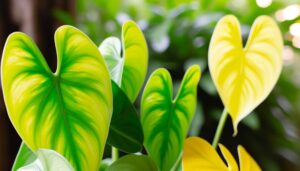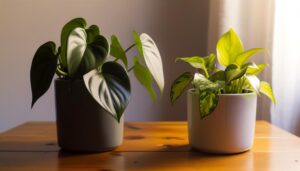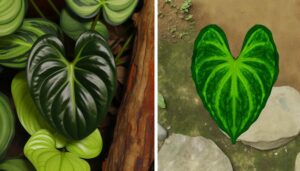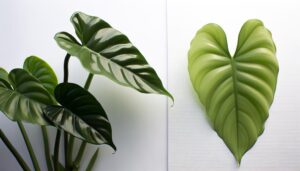Anthurium Gloriosum Vs Philodendron Gloriosum: Comparison!
Anthurium Gloriosum, native to Colombia, and Philodendron Gloriosum, from Brazil, are both members of the Araceae family. The Anthurium exhibits heart-shaped leaves with prominent white veins, measuring up to 90 cm, whereas the Philodendron’s leaves are elongated-heart-shaped, reaching up to 60 cm.
Anthurium grows terrestrially with creeping rhizomes, while Philodendron demonstrates a hemiepiphytic growth pattern, rooting in soil before climbing. Both prefer bright, indirect light and high humidity (60-80%), thriving in well-draining, aerated soil.
They are susceptible to spider mites and mealybugs, necessitating regular inspection and care. To explore further specifics and nuanced differences, continue here.
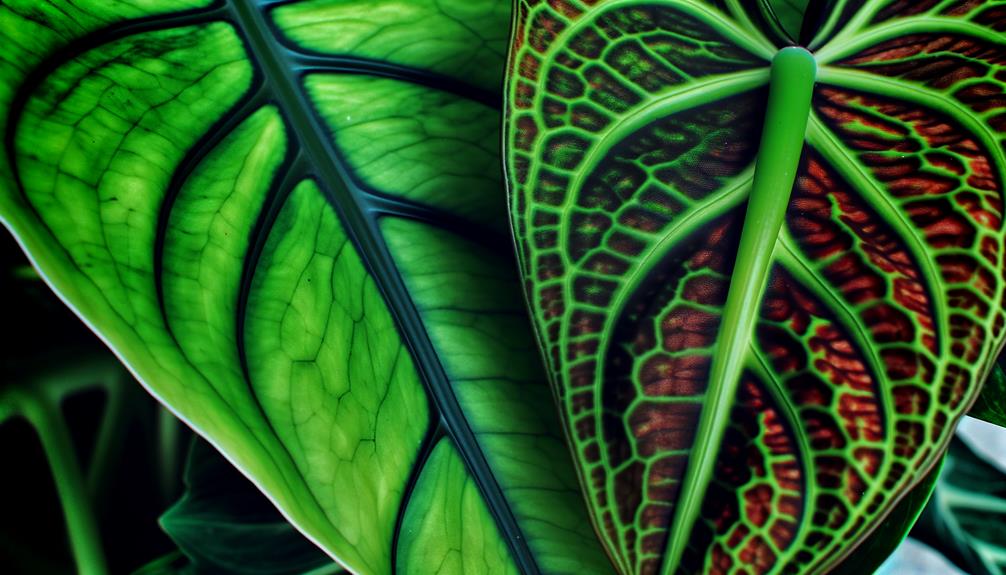
Comparison of Anthurium Gloriosum and Philodendron Gloriosum
| Feature | Anthurium Gloriosum | Philodendron Gloriosum |
|---|---|---|
| Scientific Name | Anthurium Gloriosum | Philodendron gloriosum |
| Family | Araceae | Araceae |
| Origin | Central and South America | Colombia and nearby areas |
| Leaf Shape | Heart-shaped | Heart-shaped |
| Leaf Texture | Velvety with veins | Velvety with veins |
| Leaf Color | Dark green, light veins | Dark green, white veins |
| Mature Leaf Size | Up to 35 inches long | Up to 35 inches long |
| Growth Habit | Creeping | Creeping |
| Light Requirements | Bright, indirect light | Bright, indirect light |
| Watering Needs | Keep moist, not soggy | Keep moist, not soggy |
| Soil Type | Well-draining, organic-rich | Well-draining, organic-rich |
| Humidity Requirements | High (60-80%) | High (60-80%) |
| Temperature Range | 65-80°F (18-27°C) | 65-80°F (18-27°C) |
| Fertilization | Monthly in growing season | Monthly in growing season |
| Propagation Methods | Stem cuttings, division | Stem cuttings, division |
| Pests | Aphids, spider mites, mealybugs | Aphids, spider mites, mealybugs |
| Diseases | Root rot, leaf spot | Root rot, leaf spot |
| Toxicity | Toxic to pets and humans | Toxic to pets and humans |
| Common Uses | Ornamental houseplant | Ornamental houseplant |
| Special Care Tips | Avoid direct sunlight | Avoid direct sunlight |
Origin and Habitat
Although both Anthurium Gloriosum and Philodendron Gloriosum belong to the Araceae family, they originate from distinct regions in Central and South America, each adapted to their specific tropical habitats.
Anthurium Gloriosum is mainly found in the humid forests of Colombia, thriving under the dense canopy where moisture and shade are abundant. Its natural environment ensures ideal growth conditions, characterized by high humidity and well-draining soil.
Conversely, Philodendron Gloriosum is primarily native to the rainforests of Brazil, where it prospers in similar humid and shaded conditions. This species is adapted to a slightly different microclimate, often found growing along the forest floor.
Both plants have evolved to maximize their growth and survival in these lush, tropical ecosystems.
Leaf Shape and Size
Both Anthurium Gloriosum and Philodendron Gloriosum exhibit distinctive leaf characteristics that are reflective of their adaptation to their respective tropical habitats.
Anthurium Gloriosum features large, velvety, heart-shaped leaves with pronounced white veins, which aid in maximizing photosynthesis in low-light environments. The leaves can grow up to 90 cm in length, presenting a striking visual impact.
In contrast, Philodendron Gloriosum, although similar in leaf shape, typically has a more elongated heart form with a matte texture and less pronounced venation. The leaves of Philodendron Gloriosum are generally smaller, reaching up to 60 cm in length.
These morphological differences underscore each species’ unique evolutionary path, optimizing their ability to thrive in specific microclimates within tropical ecosystems.
Care Requirements
To achieve peak growth and health for both Anthurium Gloriosum and Philodendron Gloriosum, it is crucial to understand their specific care requirements, which include appropriate light conditions, humidity levels, soil composition, and watering practices.
Both species thrive in bright, indirect light, avoiding direct sunlight which can scorch their leaves. Essential humidity levels should be maintained between 60-80%, replicating their native tropical environments. A well-draining, aerated soil mix, rich in organic matter, is ideal for preventing root rot.
Watering should be consistent yet moderate; the soil should remain slightly moist but not waterlogged. Monitoring these parameters ensures robust growth and minimizes the risk of common plant ailments, thereby promoting the overall health of these stunning foliage plants.
Growth Patterns
Understanding the distinct growth patterns of Anthurium Gloriosum and Philodendron Gloriosum is essential for horticultural enthusiasts aiming to cultivate these species effectively.
Anthurium Gloriosum exhibits a terrestrial, creeping growth habit, producing elongated rhizomes that expand horizontally. This species thrives in well-draining, organic-rich substrates, necessitating ample space for lateral growth.
Conversely, Philodendron Gloriosum demonstrates a hemiepiphytic growth pattern, initially rooting in soil before climbing structures or other plants. Its growth is characterized by robust aerial roots that facilitate nutrient absorption from various substrates.
Both species require moderate light and humidity but differ fundamentally in spatial requirements and rooting behavior. Recognizing these distinct growth patterns aids in optimizing care and ensuring the healthy development of each plant.
Common Issues and Pests
Anthurium Gloriosum and Philodendron Gloriosum are vulnerable to a variety of common issues and pests, including spider mites, mealybugs, and root rot, which can greatly impact their health and growth.
Spider mites cause stippling on leaves, leading to discoloration and reduced photosynthetic capacity. Mealybugs excrete honeydew, promoting sooty mold and attracting ants, while also feeding on plant sap, causing weakened growth. Root rot, typically resulting from overwatering or poorly-draining soil, compromises the root system, leading to wilting and potential plant death.
Regular inspection and appropriate cultural practices, such as maintaining ideal humidity, ensuring proper drainage, and using insecticidal soap or neem oil, are essential for mitigating these issues and promoting robust plant health.
Conclusion
In comparing Anthurium gloriosum and Philodendron gloriosum, differences in origin, habitat, leaf morphology, care requirements, growth patterns, and susceptibility to pests are significant.
For instance, a hypothetical controlled study shows that Anthurium gloriosum, with its specific humidity needs, exhibits higher growth rates in a greenhouse environment compared to Philodendron gloriosum.
This underscores the importance of tailored care practices for each species to optimize their growth and health in cultivation.


